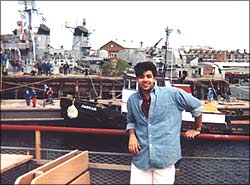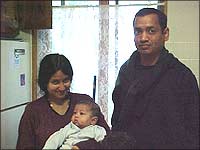The Rediff US Special/Aseem Chhabra

Three years ago, Merrill Lynch, one of the world's leading financial management and advisory companies with operations in 44 countries and total client assets of about $1.6 trillion, came up with a small but innovative plan.
It launched an innovation grants competition with the goal of facilitating and introducing academic research into the real world of commercial applications. Towards this goal, the company awarded $500,000 in grants and introduced several researchers to venture capitalists and other industry leaders.
Last week, 11 winners from six universities around the world were given a chance a talk about their projects to the non-academic world. Two of the winners, now based in the United States, are originally from India. They spoke to
rediff.com about their research, their goals and their vision of the future.
Amit Mehra grew up in New Delhi, fascinated by airplanes, though his first experience with a model plane was a disaster. The plane, a gift from his older brother, crashed into a tree ten minutes after taking off.

|
|
Amit Mehra
| |
The son of a retired marine engineer, Mehra remembers hearing stories about large engine rooms in the ships that his father would sail in. The stories were mesmerizing and Mehra was determined to become an engineer himself. But it was not until he joined the undergraduate engineering programme at the California Institute of Technology in Pasadena in 1991 that he became interested in airplane engines.
Last week the research that Mehra, 28, conducted for his doctoral thesis at the Massachusetts Institute of Technology, Cambridge, on a silicon micro-engine combustor, won him first prize in the Merrill Lynch innovation grants competition. The $50,000 award comes with no strings attached, he says.
"My research is part of a larger project at MIT that's been going on for five years," Mehra explains from Washington, DC, where he now works for Dean & Co, a business strategy consulting firm. "The overall project goal is to make a very small jet engine that you can put in consumer electronic devices such as laptops and cell phones."
"The idea is that since aircraft engines produce so much power in such a small volume, if you can miniaturize that kind of power down to the palm of your hand, you are talking about a battery that can run ten times longer or is ten times smaller in weight."
Mehra's specific research has been focused on demonstrating the combustor of the engine. The combustor, he explains, is the portion where you add fuel.
"What we have shown is that yes, it's possible to burn energy in volumes this small," Mehra says. "The combustor itself cannot produce electricity. It has to work with other components of the engine to burn the energy into electricity. By demonstrating this core technology, I have hopefully shown that this is possible. There is still plenty of work to be done to make a working electrical battery."
The individual components of the project have been demonstrated by other graduate, doctoral and post-doctoral students at MIT. The components now need to be integrated, Mehra says, adding that the technology is not yet ready for application.
Mehra says that he submitted his project for the Merrill Lynch competition to publicize his research to a new audience, outside the realm of technical colleagues who attend professional conferences.
Mehra was 18 when he joined Caltech and remembers his experiences fondly. "It is a very small, friendly environment with 200 students in every class," he says. "You come to a foreign country, it's very easy at the age of 18, because you are young and you are exposed to a lot of new things. I think people who arrive here in the latter part of their life, I think it's harder to assimilate as you grow older."
In Cambridge, while pursuing his graduate and doctoral work, Mehra was bitten by the golf bug. One of the things he realized in graduate school was that he had the flexibility of planning his day. "And so if tee time is at four in the afternoon, you can shuffle your schedule around, instead of having to play on the weekends," he says adding that his golf is still not great. "I think I can barely shoot in the high nineties."
As he moves along with his research on a miniature combustor for a small jet engine, Mehra's days of crashing the model plane into a tree are long past him. "At least I hope I know how not to get them into trees anymore," he laughs.

|
|
Satyabrata Patnaik with wife Priyadarshani and five-month-old son Swastik
| |
In discussing his research on defects in high temperature superconductors, Satyabrata Patnaik uses names like Thomas Alva Edison and Heike Kamerlingh Onnes, two pioneers in the field of electricity.
"Edison said he would make electricity so cheap that only the rich would want to buy candles," says Patnaik, 32, one of the two second-place winners (a $20,000 award) of the Merrill Lynch innovation grants competition. "Now, that dream of Edison has been realized."
"The second dream came from Kamerlingh Onnes who discovered superconductivity and won the Noble Prize for physics in 1913," says Patnaik, who was born in Keonjhar, a small town in Orissa. "In his Nobel lecture, he talked about using electrical appliances without using electrical power. That's a great dream. It's a challenging dream."
The idea behind Onnes's vision, which eventually influenced Patnaik to conduct his doctoral research at the Indian Institute of Technology, Kanpur -- he graduated in 2000 -- was that once current flows through a superconductor, it does not die. It is almost close to a perennial source of energy, he says.
Patnaik's proposal addresses one of the major obstacles prohibiting large-scale applications of superconductors. The problem, he says, is that large current flows produce a magnetic field around the superconductor, which suppresses its resistance-less property. He presents the ways and means to arrest this loss of superconductivity and the result is an improvement and a more cost-effective method of increasing the current carrying capacity.
Patnaik believes his research, which he continues to pursue as a post-doctoral scientist at the University of Wisconsin at Madison, has a practical application that will go a long way to solve our current energy crisis.
"I believe that we have almost reached the limit of energy production in the world," he says. "Unless you tinker around with nuclear power and environmentally sensitive oil drilling, you may be able to drag on for the next 50 years. What we have shown is that given the current levels of energy production, you have to improve the end-use sector more efficiently rather than produce [more] energy."
Superconductors, he says, are in the end-use sector, and because of their efficiency levels, with their ability to carry electric currents for long time, the world will have to turn to this technology.
Patnaik refers to President George W Bush's energy plan as a "myopic vision". "The president is elected for four or eight years, and he is accountable for only that time," he says. "If you look at the long term, civilization is not going to die out in 100 or 200 years. So in that sense, if any decision of the president is playing around with the environment, the future generations will blame him."
In a press release issued by Merrill Lynch, Patnaik lists politics as one of his hobbies. He has dabbled in student politics in India -- at IIT he was a student leader and president of the hostel.
"I do believe that if you want to implement your ideas on a macro level, you have to use the present political system," he says. "You have to build up your credibility so that people will listen to you. You should have enough funding of your own so that you don't depend on big industrial houses. And if you are really honest, then after the age of 40 or 45 years you should really think about giving back to the system."
In the next three to four years Patnaik plans to return to India once his wife Priyadarshani has finished her doctoral programme on sociology from the University of Wisconsin.
He would like to teach ("academics is for learning, not just a job") in Bhubaneswar, build a small network, and maybe even join politics after he turns 45. His role model in this pursuit is India's former finance minister Manmohan Singh.
"I don't talk about his political affiliation to the Congress party," Patnaik says. "But he has given the hope that if you are honest, straightforward and sincere, and you have the talent, without really spending money, you can change the problems of the society at a macro level."
Back to top
Tell us what you think of this feature

